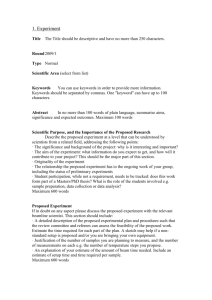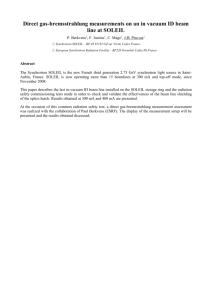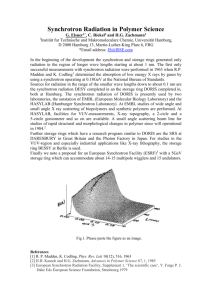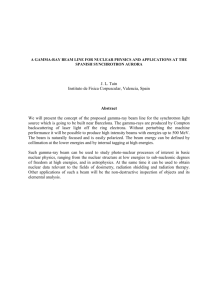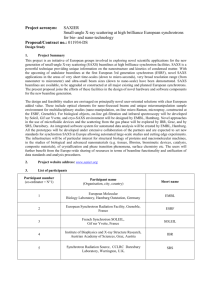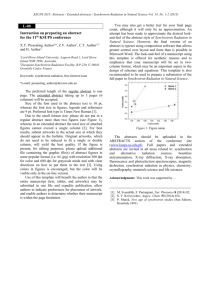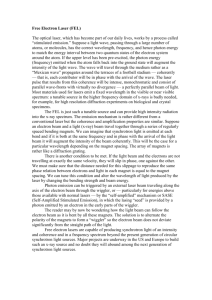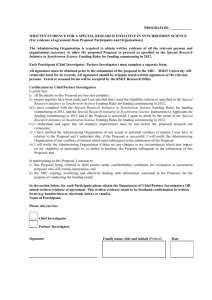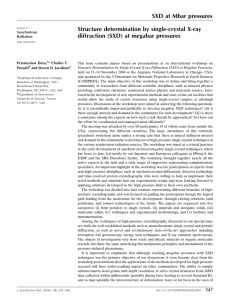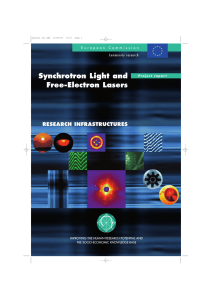Protein Crystallography in India and Synchrotron Radiation: Let
advertisement
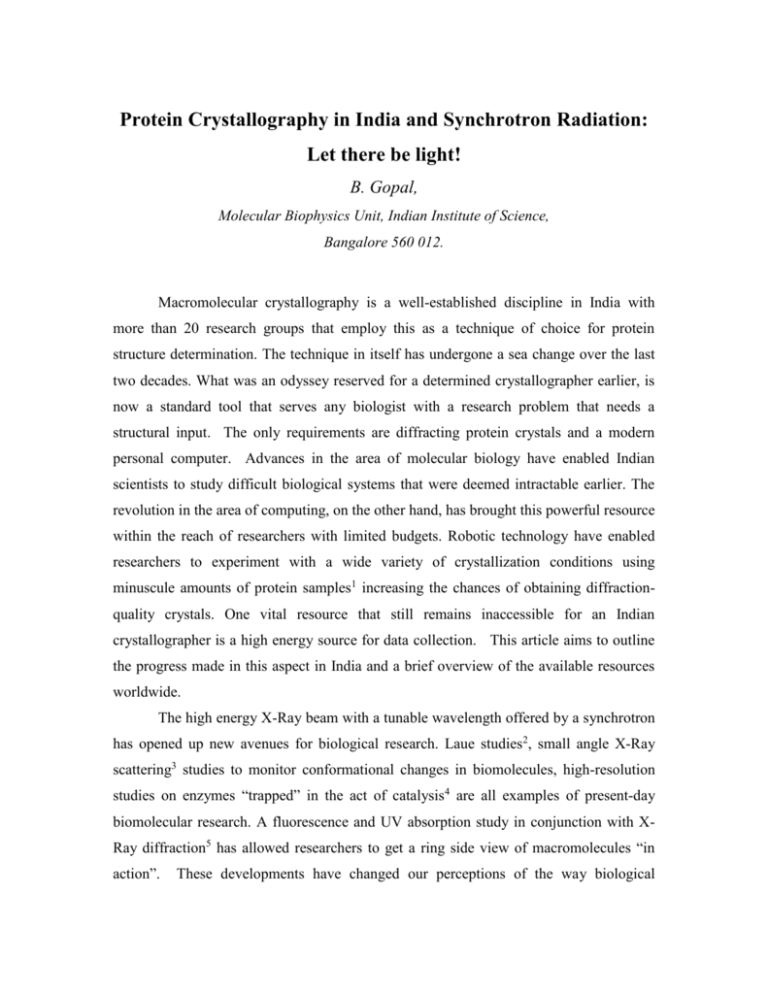
Protein Crystallography in India and Synchrotron Radiation: Let there be light! B. Gopal, Molecular Biophysics Unit, Indian Institute of Science, Bangalore 560 012. Macromolecular crystallography is a well-established discipline in India with more than 20 research groups that employ this as a technique of choice for protein structure determination. The technique in itself has undergone a sea change over the last two decades. What was an odyssey reserved for a determined crystallographer earlier, is now a standard tool that serves any biologist with a research problem that needs a structural input. The only requirements are diffracting protein crystals and a modern personal computer. Advances in the area of molecular biology have enabled Indian scientists to study difficult biological systems that were deemed intractable earlier. The revolution in the area of computing, on the other hand, has brought this powerful resource within the reach of researchers with limited budgets. Robotic technology have enabled researchers to experiment with a wide variety of crystallization conditions using minuscule amounts of protein samples1 increasing the chances of obtaining diffractionquality crystals. One vital resource that still remains inaccessible for an Indian crystallographer is a high energy source for data collection. This article aims to outline the progress made in this aspect in India and a brief overview of the available resources worldwide. The high energy X-Ray beam with a tunable wavelength offered by a synchrotron has opened up new avenues for biological research. Laue studies2, small angle X-Ray scattering3 studies to monitor conformational changes in biomolecules, high-resolution studies on enzymes “trapped” in the act of catalysis4 are all examples of present-day biomolecular research. A fluorescence and UV absorption study in conjunction with XRay diffraction5 has allowed researchers to get a ring side view of macromolecules “in action”. These developments have changed our perceptions of the way biological molecules function and formed the necessary underpinning for studies on these protein factors in vivo. Present day synchrotrons define big-budget science6. The technology involved is rather well standardized with companies that deliver ready-to-use synchrotrons on a turnkey basis. The Canadian Light Source is an example of this system. The cost varies from country to country. Japan is probably the most expensive with the on-going rate for a third generation synchrotron being US $ 1 million per meter of the synchrotron ring. In Shanghai, the number seems to be one half to one third. SESAME, the middle-east synchrotron, uses quite a few components recycled from BESSY, Hamburg and the SSRL, USA and is probably the least expensive. The cost seems remarkably attractive with the synchrotron building costing US $ 5 million, while the ring costs US $ 12 million and beam lines come with a price tag of US $ 20 million. It thus appears that, as a nation, having a synchrotron is not prohibitively expensive. Indeed, efforts to have an Indian synchrotron have been pursued for the past two decades at the Center for Advanced Technology, Indore. One beam line that holds a lot of promise for protein crystallographers is the Indus-2 designed by scientists7 at the Bhabha Atomic Research Center, Mumbai and the Center for Advanced Technology, Indore. It has a spectral range of 5-25 keV with a photon flux of 109 photons /sec. The plans for the beam line designed to study biological samples has included the possibility of carrying out Laue experiments (with limited energy band pass) and a protein crystallography beam line installed on a wavelength shifter (5T insertion device). Recent projections from the scientists involved in this project suggest that a beam line would be installed first on a bending magnet source. This would make the beam line available as soon as Indus-2 is commissioned, while the Insertion Device would be incorporated in the second stage of development. The synchrotron technology world-wide appears to be set to change in the nottoo-distant future. Existing synchrotron light sources employ multi-GeV electron beams that are stored in large rings of magnets to generate intense, bright, 1Å wavelength radiation. A similar effect can be employed by a combination of an electron and laser beam, allowing for a reduction in energy and scale by a factor of 200. Indeed, models like the Unisantis Laboratory8 synchrotron exist which allow beam size 20 to 300 µm, X- Ray focal spot 10 µm, energy range 5 to 17 KeV, beam divergence < 4 mrad and usable flux up to 1010 photons/sec.mm2. Another company, Lyncean Technologies, Inc9 has been involved in the development of laser driven table top synchrotrons. The compact light source (CLS) that this company promotes is so small that it fits within a small room and its electron storage ring fits within the footprint of a large desk. These technologies are in their early development stages. In case a prototype of such a laser driven synchrotron is shown to have the high photon flux and stability needed for protein crystallography, the lack of access to high energy sources may indeed become a thing of the past. These developments convince us that the day is not too far when Indian protein crystallography will technologically be 'in synch' with the best in the world again. References 1. Protein solutions, Inc. http://www.proterion.com/ps_dynapro.html 2. Baxter, R.H., Ponomorenko, N., Srajer, V., Pahl, R., Moffat, K., and Norris, J.R. (2004). Time resolved crystallographic studies of light induced structural changes in the photosynthetic reaction center. Proc. Natl. Acad. Sci. (USA) 101, 5892-5897. 3. Akiyama, S., Fujisawa, T., Ishimori, K., Morishima, I. and Aoro, S. (2004). Activation mechanisms of transcription regulator CooA revealed by small angle X-Ray scattering. J. Mol. Biol. 341, 651-658. 3. Iwata, S. and Barber, J. (2004). Structure of photosystem-II and the molecular architecture of the oxygen-evolving center. Curr. Opin. Struct. Biol. 14, 447-453. 5. Karlsson, A., Parales, J.V., Parales, R.E., Gibson, D.T., Eklund, H. and Ramaswamy, S. (2003). Crystal structure of naphthalene dioxygenase: side-on binding of dioxygen to iron. Science 14, 1039-1042. 6. Soichi Wakatsuki, David Schuller, Anders Liljas, Emil Hallin, Vinay Kumar and several other experts in synchrotron technology: personal communication 7. http://www.cat.ernet.in 8. http://www.unisantis.com 9. http://www.lynceantech.com
